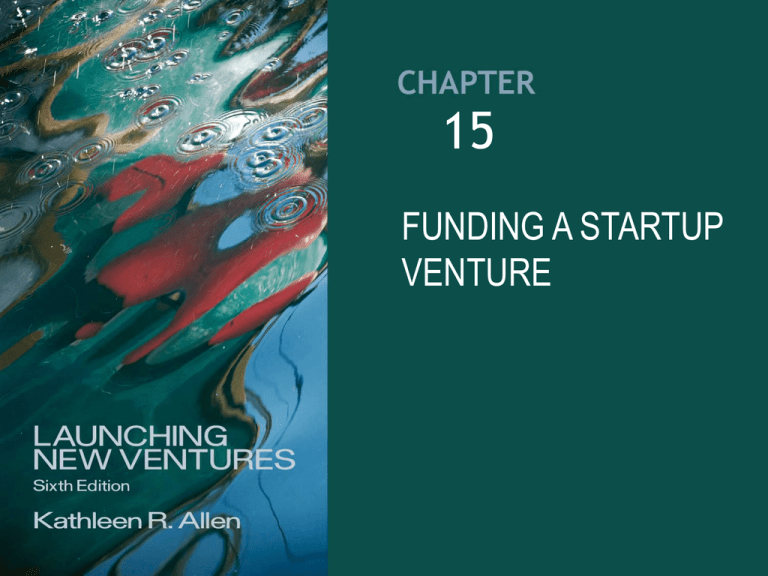
15
FUNDING A STARTUP
VENTURE
©2012 Cengage Learning. All Rights Reserved. May not be scanned, copied or duplicated, or posted to a publicly accessible website, in whole or in part.
Learning Objectives
Develop a resource strategy.
Understand the importance of a financial
plan.
Explain methods of funding with equity.
Discuss how to finance with debt.
Explore non-dilutive funding sources.
©2012 Cengage Learning. All Rights Reserved. May not be scanned, copied or duplicated, or posted to a publicly accessible website, in whole or in part.
Startup Resource Strategy
Categories of necessary resources:
•
•
•
•
Human capital
Social capital
Physical capital
Financial capital
©2012 Cengage Learning. All Rights Reserved. May not be scanned, copied or duplicated, or posted to a publicly accessible website, in whole or in part.
Startup Resource Strategy
Process for constructing a resource base:
1. Identify and specify required resources at
various milestones in the company’s growth.
2. Identify potential suppliers of those resources.
3. Assess the entrepreneur’s ability to attract
resources.
4. Combine resources to create new, unique
resources.
5. Transform individual resources into
organizational resources.
©2012 Cengage Learning. All Rights Reserved. May not be scanned, copied or duplicated, or posted to a publicly accessible website, in whole or in part.
The Financial Plan
Growth stage identification
• Startup funds are required.
• Capital required to grow on the basis of a
proven business model.
• Mezzanine financing or bridge financing
required to provide the entrepreneur with the
funds the company needs to get through an
initial public offering.
©2012 Cengage Learning. All Rights Reserved. May not be scanned, copied or duplicated, or posted to a publicly accessible website, in whole or in part.
Figure 15.2
Stages of Investment
©2012 Cengage Learning. All Rights Reserved. May not be scanned, copied or duplicated, or posted to a publicly accessible website, in whole or in part.
The Unique Funding Issues of
High-Tech Ventures
Early seed funding supports a long period of product
development – often comes from government grants or
foundations.
“Valley of death” – period from idea generation to
product development characterized by a high failure rate
“Early adopters” stage – technically-oriented users who
want leading edge technology
Marketing dollars needed to create awareness for new
adopters
“Tornado” – period of mass adoption
©2012 Cengage Learning. All Rights Reserved. May not be scanned, copied or duplicated, or posted to a publicly accessible website, in whole or in part.
Funding a Social Venture
Social ventures are focused on providing a
benefit to society.
• Typically low return on investment
• Structured as non-profits (no ownership
stakes)
“Impact investing”
Social investment funds
Seed-stage and growth-stage grants
©2012 Cengage Learning. All Rights Reserved. May not be scanned, copied or duplicated, or posted to a publicly accessible website, in whole or in part.
Funding Startups through
Bootstrapping
Bootstrapping: techniques for getting by on
as few resources as possible and using
other people’s resources whenever feasible
•
•
•
•
•
Get traction as quickly as possible
Hire as few employees as possible
Lease or share everything
Use other people’s money
Bootstrapping ethics
©2012 Cengage Learning. All Rights Reserved. May not be scanned, copied or duplicated, or posted to a publicly accessible website, in whole or in part.
Funding with Equity
Investments in a venture are generally
made to gain an ownership share in the
business, called equity.
Sources of equity financing:
•
•
•
•
•
Friends and family
Private investors—”angels”
Private placement memorandum
Venture capital institutes and networks
Small business investment companies (SBICs)
©2012 Cengage Learning. All Rights Reserved. May not be scanned, copied or duplicated, or posted to a publicly accessible website, in whole or in part.
Friends and Family
Equity from friends and family
• The most expensive long term funding.
• The entrepreneur is more likely to lose control
of the business.
©2012 Cengage Learning. All Rights Reserved. May not be scanned, copied or duplicated, or posted to a publicly accessible website, in whole or in part.
Private Investors—Angels
Angels are informal risk-capital sources.
Funding is between $10k-$500k.
Angels are often well educated
entrepreneurs who tend to invest within a
short distance from home.
Angels take an active role in the company.
©2012 Cengage Learning. All Rights Reserved. May not be scanned, copied or duplicated, or posted to a publicly accessible website, in whole or in part.
Private Placement
Memorandum
Private investments obtained by selling
securities in a private
corporation/partnership
SEC Regulation D covers memorandum
details.
Advantages:
• Few prior assets or credit references are
needed
• No SEC filing needed for entrepreneurs
©2012 Cengage Learning. All Rights Reserved. May not be scanned, copied or duplicated, or posted to a publicly accessible website, in whole or in part.
Venture Capital Institutes and
Networks
Institutes on major university campuses
offer access to venture capital networks.
University acts as conduit to match
entrepreneurs and investors.
©2012 Cengage Learning. All Rights Reserved. May not be scanned, copied or duplicated, or posted to a publicly accessible website, in whole or in part.
Small Business Investment
Companies
Small business investment Companies
(SBICs)
• Privately managed venture capital firms
licensed by the Small Business Administration
• Get financing at very favorable rates, in
partnership with the federal government, to
invest in small and growing businesses
through equity and long-term debt.
©2012 Cengage Learning. All Rights Reserved. May not be scanned, copied or duplicated, or posted to a publicly accessible website, in whole or in part.
Financing with Debt
Commercial banks
• Basis of loans:
•
•
•
•
•
Character
Capacity
Capital
Collateral
Condition
©2012 Cengage Learning. All Rights Reserved. May not be scanned, copied or duplicated, or posted to a publicly accessible website, in whole or in part.
Financing With Debt (cont’d)
Commercial finance companies
• Less regulated than banks
• High finance charges
• Factoring
• Receivable financing in which the factor takes
ownership of a receivable at a discount and then
collects against it
©2012 Cengage Learning. All Rights Reserved. May not be scanned, copied or duplicated, or posted to a publicly accessible website, in whole or in part.
Financing With Debt (cont’d)
Small Business Administration loan
• Entrepreneur applies for up to $2M loan from
his personal bank; SBA guarantees that it will
repay up to 90% of the loan to the commercial
lender should the business default.
• Micro loans exist for companies to use
nonprofit community development
corporations rather than banks.
©2012 Cengage Learning. All Rights Reserved. May not be scanned, copied or duplicated, or posted to a publicly accessible website, in whole or in part.
Other Non-Dilutive Funding
Sources
Strategic alliances: Partnerships with another
business (formal or informal).
Grants: Federal agencies with R&D budgets in
excess of $100M must give a portion to
technology-based small business in form of Small
Business Innovative Research (SBIR) grants.
State-funded incentives: Range of incentives to
help new and growing ventures.
Incubators: Places where startup ventures can
get space and support for early stages of startup.
©2012 Cengage Learning. All Rights Reserved. May not be scanned, copied or duplicated, or posted to a publicly accessible website, in whole or in part.
Looking Ahead
Part One: Entrepreneurial Opportunity (Ch 1-4)
Part Two: Feasibility Analysis (Ch 5-8)
Part Three: Business Design (Ch 9-15)
Part Four: Planning for Growth and Change
• Chapter 16: Funding a Rapidly Growing Venture
• Chapter 17: Planning for Growth
• Chapter 18: Planning for Change
©2012 Cengage Learning. All Rights Reserved. May not be scanned, copied or duplicated, or posted to a publicly accessible website, in whole or in part.
New Venture Action Plan
Calculate how many personal resources you have to help
fund a new venture.
Determine ways to bootstrap the startup of the new
venture.
Network to come into contact with potential “angels.”
Identify an attorney who can help structure any legal
documents.
Investigate the sources of debt financing in the
community.
Determine if any of the non-dilutive sources of funding
are appropriate for your business.
©2012 Cengage Learning. All Rights Reserved. May not be scanned, copied or duplicated, or posted to a publicly accessible website, in whole or in part.







